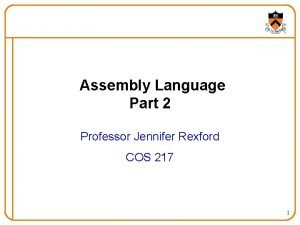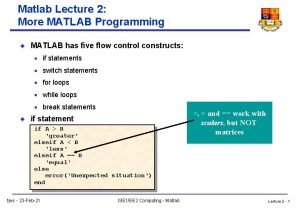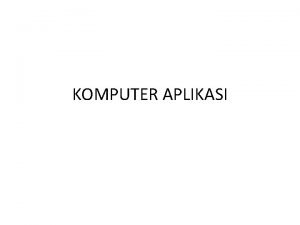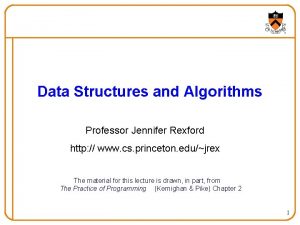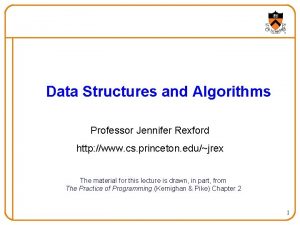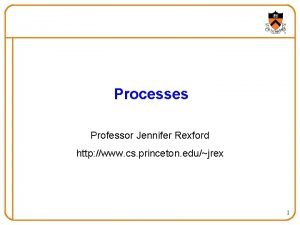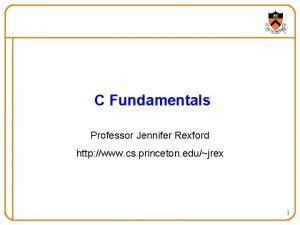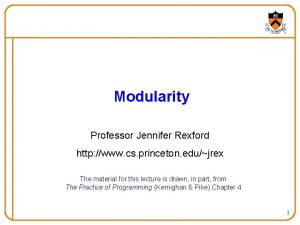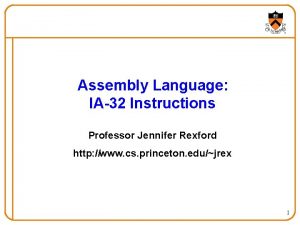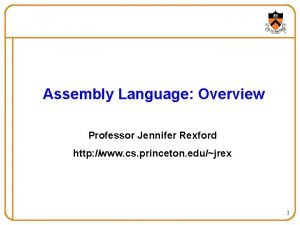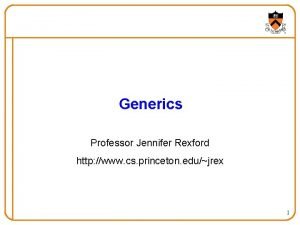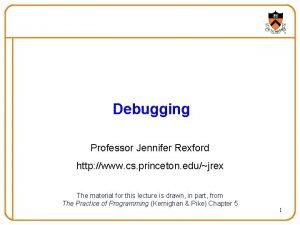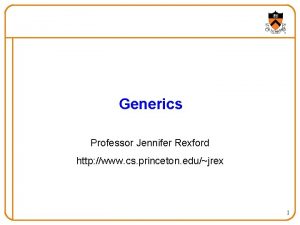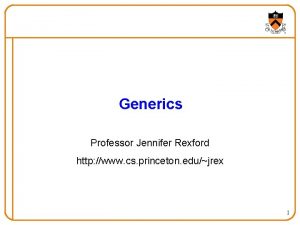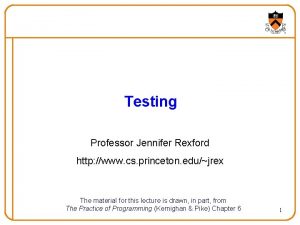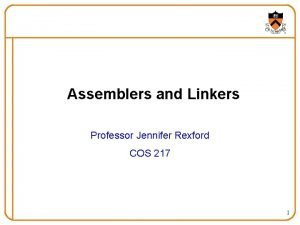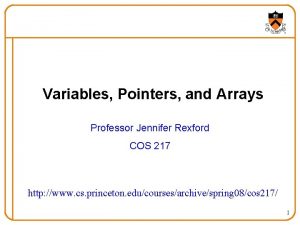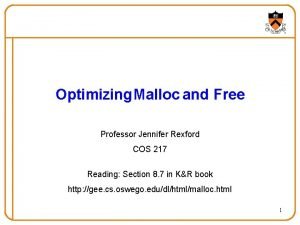Program and Programming Style Professor Jennifer Rexford http






![Structure: Spacing • Use readable/consistent spacing • Example: Assign each array element a[j] to Structure: Spacing • Use readable/consistent spacing • Example: Assign each array element a[j] to](https://slidetodoc.com/presentation_image/17cde93e10d9b8337397cb04de7c84e1/image-7.jpg)































![Printing the Last Line … int main(void) { char word[MAX_WORD_LEN + 1]; int word. Printing the Last Line … int main(void) { char word[MAX_WORD_LEN + 1]; int word.](https://slidetodoc.com/presentation_image/17cde93e10d9b8337397cb04de7c84e1/image-39.jpg)
![Deciding When to Print … int main(void) { char word[MAX_WORD_LEN + 1]; int word. Deciding When to Print … int main(void) { char word[MAX_WORD_LEN + 1]; int word.](https://slidetodoc.com/presentation_image/17cde93e10d9b8337397cb04de7c84e1/image-40.jpg)












- Slides: 52

Program and Programming Style Professor Jennifer Rexford http: //www. cs. princeton. edu/~jrex The material for this lecture is drawn, in part, from The Practice of Programming (Kernighan & Pike) Chapter 1 1

Goals of this Lecture • Help you learn about: • Good program (noun) style • Good programming (verb) style • Why? • A large program that is well styled is • easier to maintain and • more likely to be correct than a large program that is poorly styled • A power programmer knows the qualities of a well styled program, and how to go about developing one 2

Overview • Program style: qualities of a good program • • • Well structured Uses common idioms Uses descriptive names Contains proper comments Modular • Programming style: how to create a good program • Top-down design • Successive refinement • Example: left and right justifying text 3

Part 1: Program Style 4

Program Style • Who reads your code? • The compiler • Other programmers typedef struct{double x, y, z}vec; vec U, black, amb={. 02, . 02}; struct sphere{ vec cen, color; double rad, ks, kt, kl, ir}*s, *best, sph[]={0. , 6. , . 5, 1. , . 9, . 05, . 2, . 85, 0. , 1. 7, -1. , 8. , -. 5, 1. , . 5, . 2, 1. , . 7, . 3, 0. , . 05, 1. 2, 1. , 8. , -. 5, . 1, . 8, 1. , . 3, . 7, 0. , 1. 2, 3. , -6. , 15. , 1. , . 8, 1. , 7. , 0. , . 6, 1. 5, -3. , 12. , . 8, 1. , 5. , 0. , . 5, 1. 5, }; yx; double u, b, tmin, sqrt(), tan(); double vdot(A, B)vec A , B; {return A. x*B. x+A. y*B. y+A. z*B. z; }vec vcomb(a, A, B)double a; vec A, B; {B. x+=a* A. x; B. y+=a*A. y; B. z+=a*A. z; return B; }vec vunit(A)vec A; {return vcomb(1. /sqrt( vdot(A, A)), A, black); }struct sphere*intersect(P, D)vec P, D; {best=0; tmin=1 e 30; s= sph+5; while(s--sph)b=vdot(D, U=vcomb(-1. , P, s-cen)), u=b*b-vdot(U, U)+s-rad*s rad, u=u 0? sqrt(u): 1 e 31, u=b-u 1 e-7? b-u: b+u, tmin=u=1 e-7&&u<tmin? best=s, u: tmin; return best; }vec trace(level, P, D)vec P, D; {double d, eta, e; vec N, color; struct sphere*s, *l; if(!level--)return black; if(s=intersect(P, D)); else return amb; color=amb; eta=s-ir; d= -vdot(D, N=vunit(vcomb(-1. , P=vcomb(tmin, D, P), s-cen ))); if(d<0)N=vcomb(-1. , N, black), eta=1/eta, d= -d; l=sph+5; while(l--sph)if((e=l kl*vdot(N, U=vunit(vcomb(-1. , P, l-cen))))0&&intersect(P, U)==l)color=vcomb(e , lcolor, color); U=s-color; color. x*=U. x; color. y*=U. y; color. z*=U. z; e=1 -eta*(1 d*d); return vcomb(s-kt, e 0? trace(level, P, vcomb(eta, D, vcomb(eta*d-sqrt (e), N, black))): black, vcomb(s-ks, trace(level, P, vcomb(2*d, N, D)), vcomb(s-kd, color, vcomb(s-kl, U, black)))); }main(){printf("%d %dn", 32); while(yx<32*32) U. x=yx%32 -32/2, U. z=32/2 -yx++/32, U. y=32/2/tan(25/114. 5915590261), U=vcomb(255. , trace(3, black, vunit(U)), black), printf("%. 0 fn", U); } This is a working ray tracer! (courtesy of Paul Heckbert) 5

Program Style • Why does program style matter? • Bugs often caused by programmer’s misunderstanding • What does this variable do? • How is this function called? • Good code = human readable code • How can code become easier for humans to read? • • • Convey program structure Use common idioms Choose descriptive names Compose proper comments Use modularity 6
![Structure Spacing Use readableconsistent spacing Example Assign each array element aj to Structure: Spacing • Use readable/consistent spacing • Example: Assign each array element a[j] to](https://slidetodoc.com/presentation_image/17cde93e10d9b8337397cb04de7c84e1/image-7.jpg)
Structure: Spacing • Use readable/consistent spacing • Example: Assign each array element a[j] to the value j. • Bad code for (j=0; j<100; j++) a[j]=j; • Good code for (j=0; j<100; j++) a[j] = j; • Can often rely on auto-indenting feature in editor 7

Structure: Indentation (cont. ) • Use readable/consistent indentation • Example: Checking for leap year (does Feb 29 exist? ) if (month == FEB) { if (year % 4 == 0) if (day > 29) legal = FALSE; else if (day > 28) legal = FALSE; } Wrong code (else matches “if day > 29”) if (month == FEB) { if (year % 4 == 0) { if (day > 29) legal = FALSE; } else { if (day > 28) legal = FALSE; } } Right code 8

Structure: Indentation (cont. ) • Use “else-if” for multi-way decision structures • Example: Comparison step in a binary search. • Bad code low=0 if (x < v[mid]) high = mid – 1; else if (x > v[mid]) low = mid + 1; else return mid; • Good code if (x < v[mid]) high = mid – 1; else if (x > v[mid]) low = mid + 1; else return mid; mid=3 high=6 v 2 4 5 7 8 10 17 x 10 9

Structure: “Paragraphs” • Use blank lines to divide the code into key parts #include <stdio. h> #include <stdlib. h> int main(void) /* Read a circle's radius from stdin, and compute and write its diameter and circumference to stdout. Return 0 if successful. */ { const double PI = 3. 14159; int radius; int diam; double circum; printf("Enter the circle's radius: n"); if (scanf("%d", &radius) != 1) { fprintf(stderr, "Error: Not a numbern"); exit(EXIT_FAILURE); /* or: return EXIT_FAILURE; */ } … 10

Structure: “Paragraphs” • Use blank lines to divide the code into key parts diam = 2 * radius; circum = PI * (double)diam; printf("A circle with radius %d has diameter %dn", radius, diam); printf("and circumference %f. n", circum); return 0; } 11

Structure: Expressions • Use natural form of expressions • Example: Check if integer n satisfies j < n < k • Bad code if (!(n >= k) && !(n <= j)) • Good code if ((j < n) && (n < k)) • Conditions should read as you’d say them aloud • Not “Conditions shouldn’t read as you’d never say them aloud”! 12

Structure: Expressions (cont. ) • Parenthesize to resolve ambiguity • Example: Check if integer n satisfies j < n < k • Moderately bad code if (j < n && n < k) • Moderately better code if ((j < n) && (n < k)) • Good to make the groupings explicit • Relational operators (e. g. , “>”) have precedence over logical operators (e. g. , “&&”), but who can remember these things? 13

Structure: Expressions (cont. ) • Parenthesize to resolve ambiguity (cont. ) • Example: read and print character until the end-of-file. • Wrong code (what will it do? ? ? ) while (c = getchar() != EOF) putchar(c); • Right code while ((c = getchar()) != EOF) putchar(c); • Must make the grouping explicit • Logical operator (“!=“) has precedence over assignment (“=“) 14

Structure: Expressions (cont. ) • Break up complex expressions • Example: Identify chars corresponding to months of year • Bad code if ((c == 'J') || (c == 'F') || (c == 'M') || (c == 'A') || (c == 'S') || (c == 'O') || (c == 'N') || (c == 'D')) • Good code if ((c (c == == 'J') 'M') 'S') 'N') || || (c (c == == 'F') || 'A') || 'O') || 'D')) • Lining up the parallel structures is helpful, too! 15

C Idioms • Use C idioms • Example: Set each array element to 1. 0. • Bad code (or, perhaps just “so-so” code) i = 0; while (i <= n-1) array[i++] = 1. 0; • Good code for (i=0; i<n; i++) array[i] = 1. 0; • We’ll see many C idioms throughout the course • Don’t feel obliged to use C idioms that decrease clarity 16

Naming • Use descriptive names for globals and functions • E. g. , display, CONTROL, CAPACITY • Use concise names for local variables • E. g. , i (not array. Index) for loop variable • Use case judiciously • E. g. , Buffer_Insert (Module_function) CAPACITY (constant) buf (local variable) • Use a consistent style for compound names • E. g. , frontsize, front. Size, front_size • Use active names for functions • E. g. , getchar(), putchar(), Check_Octal(), etc. 17

Comments • Master the language and its idioms • Let the code speak for itself • And then… • Compose comments that add new information i++; /* add one to i */ • Comment sections (“paragraphs”) of code, not lines of code • E. g. , “Sort array in ascending order” • Comment global data • Global variables, structure type definitions, etc. • Compose comments that agree with the code!!! • And change as the code itself changes. 18

Comments (cont. ) • Comment sections (“paragraphs”) of code, not lines of code #include <stdio. h> #include <stdlib. h> int main(void) /* Read a circle's radius from stdin, and compute and write its diameter and circumference to stdout. Return 0 if successful. */ { const double PI = 3. 14159; int radius; int diam; double circum; /* Read the circle’s radius. */ printf("Enter the circle's radius: n"); if (scanf("%d", &radius) != 1) { fprintf(stderr, "Error: Not a numbern"); exit(EXIT_FAILURE); /* or: return EXIT_FAILURE; */ } … 19

Comments (cont. ) /* Compute the diameter and circumference. */ diam = 2 * radius; circum = PI * (double)diam; /* Print the results. */ printf("A circle with radius %d has diameter %dn", radius, diam); printf("and circumference %f. n", circum); return 0; } 20

Function Comments • Describe what a caller needs to know to call the function properly • Describe what the function does, not how it works • Code itself should be readable enough to reveal how it works… • If not, compose “paragraph” comments within definition • Describe inputs: parameters, files read, global variables used • Describe outputs: return value, parameters, files written, global variables affected • Refer to parameters by name 21

Function Comments (cont. ) • Bad function comment /* decomment. c */ int main(void) { /* Read a character. Based upon the character and the current DFA state, call the appropriate state-handling function. Repeat until end-of-file. */ … } • Describes how the functionworks 22

Function Comments (cont. ) • Good function comment /* decomment. c */ int main(void) { /* Read a C program from stdin. Write it to stdout with each comment replaced by a single space. Preserve line numbers. Return 0 if successful, EXIT_FAILURE if not. */ … } • Describes what the functiondoes 23

Modularity • Big programs are harder to write than small ones • “A dog house can be built without any particular design, using whatever materials are at hand. A house for humans, on the other hand, is too complex to just throw together. ” – K. N. King • Abstraction is the key to managing complexity • Abstraction allows programmer to know what something does without knowing how • Examples of function-level abstraction • Function to sort an array of integers • Character I/O functions, e. g. getchar() and putchar() • Mathematical functions, e. g. lcm() and gcd() • Examples of file-level abstraction • (Described in a later lecture) 24

Part 2: Programming Style 25

Bottom-Up Design is Bad • Bottom-up design • Design one part in detail • Design another part in detail • Repeat until finished • Bottom-up design in painting • • Paint upper left part of painting in complete detail Paint next part of painting in complete detail Repeat until finished Note: Unlikely to produce a good painting … 1 2 • Bottom-up design in programming • • Write first part of program in complete detail Write next part of program in complete detail Repeat until finished Note: Unlikely to produce a good program 1 2 3 4 … 26

Top-Down Design is Good • Top-down design • Design entire product with minimal detail • Successively refine until finished • Top-down design in painting • Sketch the entire painting with minimal detail • Successively refine the entire painting • Top-down design in programming • Define main() function in pseudocode with minimal detail • Refine each pseudocode statement • Small job => replace with real code 2 • Large job => replace with function call • Recurse in (mostly) breadth-first order 4 5 • Bonus: Product is naturally modular 1 3 … 27

Top-Down Design in Reality • Top-down design in programming in reality • Define main() function in pseudocode • Refine each pseudocode statement • Oops! Details reveal design error, so… • Backtrack to refine existing (pseudo)code, and proceed • Recurse in (mostly) breadth-first order, until all functions are defined 1 2 Oops 1’ 2’ 1’ 3 2’ 4 1’’ 3 Oops 2’’ 4’ 3’ 5 … 28

Example: Text Formatting • Goals of the example • Illustrate good program and programming style • Especially function-level modularity and top-down design • Illustrate how to go from problem statement to code • Review and illustrate C constructs • Text formatting (derived from King Section 15. 3) • Input: ASCII text, with arbitrary spaces and newlines • Output: the same text, left and right justified • Fit as many words as possible on each 50 -character line • Add even spacing between words to right justify the text • No need to right justify the very last line • Simplifying assumptions • Word ends with space, tab, newline, or end-of-file • No word is longer than 20 characters 29

Example Input and Output I N P U T Tune every heart and every voice. Bid every bank withdrawal. Let's all with our accounts rejoice. In funding Old Nassau we spend more money every year. Our banks shall give, while we shall live. We're funding Old Nassau. O U T P U T Tune every heart and every voice. Bid every bank withdrawal. Let's all with our accounts rejoice. In funding Old Nassau we spend more money every year. Our banks shall give, while we shall live. We're funding Old Nassau. 30

Thinking About the Problem • I need a notion of “word” • Sequence of characters with no white space, tab, newline, or EOF • All characters in a word must be printed on the same line • I need to be able to read and print words • Read characters from stdin till white space, tab, newline, or EOF • Print characters to stdout followed by white space(s) or newline • I need to deal with poorly-formatted input • I need to remove extra white spaces, tabs, and newlines in input • Unfortunately, I can’t print the words as they are read • I don’t know # of white spaces needed till I read the future words • Need to buffer the words until I can safely print an entire line • But, how much space should I add between words? • Need at least one space between adjacent words on a line • Can add extra spaces evenly to fill up an entire line 31

Writing the Program • Key constructs • Word • Line • Next steps • Write pseudocode for main() • Successively refine • Caveats concerning the following presentation • Function comments and some blank lines are omitted because of space constraints • Don’t do that!!! • Design sequence is idealized • In reality, much backtracking would occur 32

The Top Level • First, let’s sketch main()… int main(void) { <Clear line> for (; ; ) { <Read a word> if (<No more words>) { <Print line with no justification> return 0; } if (<Word doesn’t fit on this line>) { <Print line with justification> <Clear line> } <Add word to line> } return 0; } 33

Reading a Word #include <stdio. h> • Now let’s successively enum {MAX_WORD_LEN = 20}; refine. What does <Read int main(void) { word> mean? The job char word[MAX_WORD_LEN + 1]; int word. Len; seems complicated <Clear line> enough that it should be for (; ; ) { word. Len = Read. Word(word); delegated to a distinct if (<No more words>) { function… <Print line with no justification> return 0; } if (<Word doesn’t fit on this line>) { <Print line with justification> <Clear line> } <Add word to line> int Read. Word(char *word) { } <Skip over whitespace> return 0; <Store chars up to MAX_WORD_LEN in word> } <Return length of word> } a 34

Reading a Word (cont. ) • The Read. Word() function seems easy enough to design. So let’s flesh it out… int Read. Word(char *word) { int ch, pos = 0; /* Skip over whitespace. */ ch = getchar(); while ((ch == ' ') || (ch == 'n') || (ch == 't')) ch = getchar(); /* Store chars up to MAX_WORD_LEN in word. */ while ((ch != ' ') && (ch != 'n') && (ch != 't') && (ch != EOF)) { if (pos < MAX_WORD_LEN) { word[pos] = (char)ch; pos++; } ch = getchar(); } word[pos] = '�'; /* Return length of word. */ return pos; } 35

Reading a Word (cont. ) int Read. Word(char *word) { int ch, pos = 0; /* Skip over whitespace. */ ch = getchar(); while (Is. Whitespace(ch)) ch = getchar(); • Hmmm. Read. Word() contains some duplicate code. That could affect maintainability, and often is a sign of poor design. Let’s factor the duplicate code into a function, and call the function from two places… /* Store chars up to MAX_WORD_LEN in word. */ while (!Is. Whitespace(ch) && (ch != EOF)) { if (pos < MAX_WORD_LEN) { word[pos] = (char)ch; pos++; } ch = getchar(); } word[pos] = '�'; int Is. Whitespace(int ch) { return (ch == ' ') || (ch == 'n') || (ch == 't'); /* Return length of } word. */ return pos; } • Really clever? Use isspace( ) from ctype. h 36

Saving a Word #include <stdio. h> • Now, back to main(). What #include <string. h> does <Add word to line> enum {MAX_WORD_LEN = 20}; enum {MAX_LINE_LEN = 50}; mean? The job seems int main(void) { complicated enough to char word[MAX_WORD_LEN + 1]; demand a distinct int word. Len; char line[MAX_LINE_LEN + 1]; function… int line. Len = 0; <Clear line> for (; ; ) { word. Len = Read. Word(word); if (<No more words>) { char *word, char *line, int *line. Len) { <Print void line Add. Word(const with no justification> return 0; <if line already contains some words, append a space> strcat(line, word); } (*line. Len) strlen(word); if (<Word doesn’t fit on+=this line>) { } <Print line with justification> <Clear line> } Add. Word(word, line, &line. Len); } return 0; } 37

Saving a Word (cont. ) • Add. Word() is almost complete already, so let’s get that out of the way. . . void Add. Word(const char *word, char *line, int *line. Len) { /* If line already contains some words, append a space. */ if (*line. Len > 0) { line[*line. Len] = ' '; line[*line. Len + 1] = '�'; (*line. Len)++; } strcat(line, word); (*line. Len) += strlen(word); } 38
![Printing the Last Line int mainvoid char wordMAXWORDLEN 1 int word Printing the Last Line … int main(void) { char word[MAX_WORD_LEN + 1]; int word.](https://slidetodoc.com/presentation_image/17cde93e10d9b8337397cb04de7c84e1/image-39.jpg)
Printing the Last Line … int main(void) { char word[MAX_WORD_LEN + 1]; int word. Len; char line[MAX_LINE_LEN + 1]; int line. Len = 0; <Clear line buffer> for (; ; ) { word. Len = Read. Word(word); /* If no more words, print line with no justification. */ if ((word. Len == 0) && (line. Len > 0)) { puts(line); return 0; } if (<Word doesn’t fit on this line>) { <Print line with justification> <Clear line buffer> } Add. Word(word, line, &line. Len); • Again, back to main(). What do <No more words> and <Print line with no justification> mean? Those jobs seem easy enough that we need not define additional functions… } return 0; } 39
![Deciding When to Print int mainvoid char wordMAXWORDLEN 1 int word Deciding When to Print … int main(void) { char word[MAX_WORD_LEN + 1]; int word.](https://slidetodoc.com/presentation_image/17cde93e10d9b8337397cb04de7c84e1/image-40.jpg)
Deciding When to Print … int main(void) { char word[MAX_WORD_LEN + 1]; int word. Len; char line[MAX_LINE_LEN + 1]; int line. Len = 0; <Clear line buffer> for (; ; ) { word. Len = Read. Word(word); • What does <Word doesn’t fit on this line> mean? That’s somewhat tricky, but involves little code… /* If no more words, print line with no justification. */ if ((word. Len == 0) && (line. Len > 0)) { puts(line); return 0; } /* If word doesn't fit on this line, then… */ if ((word. Len + 1 + line. Len) > MAX_LINE_LEN) { <Print line with justification> <Clear line buffer> } Add. Word(word, line, &line. Len); } return 0; } 40

Printing with Justification • Now, to the heart of the program. What does <Print line with justification> mean? Certainly that job demands a distinct function. Moreover, it’s clear that the function must know how many words are in the given line. So let’s change main() accordingly… … int main(void) { … int num. Words = 0; <Clear line> for (; ; ) { … /* If word doesn't fit on this line, then… */ if ((word. Len + 1 + line. Len) > MAX_LINE_LEN) { Write. Line(line, line. Len, num. Words); <Clear line> } Add. Word(word, line, &line. Len); num. Words++; } return 0; } 41

Printing with Justification (cont. ) • And write pseudocode for Write. Line()… void Write. Line(const char *line, int line. Len, int num. Words) { <Compute number of excess spaces for line> for (i = 0; i < line. Len; i++) { if (<line[i] is not a space>) <Print the character> else { <Compute additional spaces to insert> <Print a space, plus additional spaces> } } } <Decrease extra spaces and word count> 42

Printing with Justification (cont. ) void Write. Line(const char *line, int line. Len, int num. Words) { int extra. Spaces, spaces. To. Insert, i, j; /* Compute number of excess spaces for line. */ extra. Spaces = MAX_LINE_LEN - line. Len; for (i = 0; i < line. Len; i++) { if (line[i] != ' ') putchar(line[i]); else { /* Compute additional spaces to insert. */ spaces. To. Insert = extra. Spaces / (num. Words - 1); /* Print a space, plus additional spaces. */ for (j = 1; j <= spaces. To. Insert + 1; j++) putchar(' '); /* Decrease extra spaces and word count. */ extra. Spaces -= spaces. To. Insert; num. Words--; } } putchar('n'); } • Let’s go ahead and complete Write. Line() … The number of gaps Example: If extra. Spaces is 10 and num. Words is 5, then gaps will contain 2, 2, 3, and 3 extra spaces respectively 43

Clearing the Line • One step remains. What does <Clear line> mean? It’s an easy job, but it’s done in two places. So we probably should delegate the work to a distinct function, and call the function in the two places… … int main(void) { … int num. Words = 0; Clear. Line(line, &line. Len, &num. Words); for (; ; ) { … /* If word doesn't fit on this line, then… */ if ((word. Len + 1 + line. Len) > MAX_LINE_LEN) { Write. Line(line, line. Len, num. Words); Clear. Line(line, &line. Len, &num. Words); } void Clear. Line(char *line, int *line. Len, int *num. Words) { line[0] = '�'; add. Word(word, line, &line. Len); *line. Len = 0; num. Words++; *num. Words = 0; } } return 0; } 44

Modularity: Summary of Example • To the user of the program • Input: Text in messy format • Output: Same text left and right justified, looking mighty pretty • Between parts of the program • Word-handling functions • Line-handling functions • main() function • The many benefits of modularity • • Reading the code: In small, separable pieces Testing the code: Test each function separately Speeding up the code: Focus only on the slow parts Extending the code: Change only the relevant parts 45

Summary • Program style • • • Convey program structure (spacing, indentation, parentheses) Use common C idioms Choose consistent and descriptive names (for variables, functions) Compose proper comments, especially for functions Modularity (divide program into modules, and files) • Programming style • Think about the problem • Use top-down design and successive refinement • But know that backtracking inevitably will occur • Reading this week • Required, King book: chapters 16, 17, and 19 • Recommended: K&P book: chapters 1 and 2 46

Appendix: The “justify” Program #include <stdio. h> #include <string. h> enum {MAX_WORD_LEN = 20}; enum {MAX_LINE_LEN = 50}; int Is. Whitespace(int ch) { /* Return 1 (TRUE) iff ch is a whitespace character. */ return (ch == ' ') || (ch == 'n') || (ch == 't'); } Continued on next slide 47

Appendix: The “justify” Program int Read. Word(char *word) { /* Read a word from stdin. Assign it to word. Return the length of the word, or 0 if no word could be read. */ int ch, pos = 0; /* Skip over whitespace. */ ch = getchar(); while (Is. Whitespace(ch)) ch = getchar(); /* Store chars up to MAX_WORD_LEN in word. */ while (!Is. Whitespace(ch) && (ch != EOF)) { if (pos < MAX_WORD_LEN) { word[pos] = (char)ch; pos++; } ch = getchar(); } word[pos] = '�'; /* Return length of word. */ return pos; } Continued on next slide 48

Appendix: The “justify” Program void Clear. Line(char *line, int *line. Len, int *num. Words) { /* Clear the given line. That is, clear line, and set * line. Len and *num. Words to 0. */ line[0] = '�'; *line. Len = 0; *num. Words = 0; } void Add. Word(const char *word, char *line, int *line. Len) { /* Append word to line, making sure that the words within line are separated with spaces. Update * line. Len to indicate the new line length. */ /* If line already contains some words, append a space. */ if (*line. Len > 0) { line[*line. Len] = ' '; line[*line. Len + 1] = '�'; (*line. Len)++; } strcat(line, word); (*line. Len) += strlen(word); } Continued on next slide 49

Appendix: The “justify” Program void Write. Line(const char *line, int line. Len, int num. Words) { /* Write line to stdout, in right justified form. line. Len indicates the number of characters in line. num. Words indicates the number of words in line. */ int extra. Spaces, spaces. To. Insert, i, j; for (i = 0; i < line. Len; i++) { if (line[i] != ' ') putchar(line[i]); else { /* Compute additional spaces to insert. */ spaces. To. Insert = extra. Spaces / (num. Words - 1); /* Print a space, plus additional spaces. */ for (j = 1; j <= spaces. To. Insert + 1; j++) putchar(' '); /* Decrease extra spaces and word count. */ extra. Spaces -= spaces. To. Insert; num. Words--; } } putchar('n'); } Continued on next slide /* Compute number of excess spaces for line. */ extra. Spaces = MAX_LINE_LEN - line. Len; 50

Appendix: The “justify” Program int main(void) { /* Read words from stdin, and write the words in justified format to stdout. */ /* Simplifying assumptions: Each word ends with a space, tab, newline, or end-of-file. No word is longer than MAX_WORD_LEN characters. */ char word[MAX_WORD_LEN + 1]; int word. Len; char line[MAX_LINE_LEN + 1]; int line. Len = 0; int num. Words = 0; Clear. Line(line, &line. Len, &num. Words); … Continued on next slide 51

Appendix: The “justify” Program … for (; ; ) { word. Len = Read. Word(word); /* If no more words, print line with no justification. */ if ((word. Len == 0) && (line. Len > 0)) { puts(line); break; } /* If word doesn't if ((word. Len + 1 + Write. Line(line, Clear. Line(line, } fit on this line, then. . . */ line. Len) > MAX_LINE_LEN) { line. Len, num. Words); &line. Len, &num. Words); Add. Word(word, line, &line. Len); num. Words++; } return 0; } 52
 Assembly language instruction
Assembly language instruction Gao rexford conditions
Gao rexford conditions Promotion from associate professor to professor
Promotion from associate professor to professor Professor name style
Professor name style Salutation mark
Salutation mark Perbedaan linear programming dan integer programming
Perbedaan linear programming dan integer programming Greedy vs dynamic programming
Greedy vs dynamic programming System programming definition
System programming definition Integer programming vs linear programming
Integer programming vs linear programming Programing adalah
Programing adalah If not equal matlab
If not equal matlab Formal and informal word
Formal and informal word Informal vs formal writing examples
Informal vs formal writing examples Referential vs expressive style
Referential vs expressive style Inversion poetry example
Inversion poetry example Cumulative sentence
Cumulative sentence Http //mbs.meb.gov.tr/ http //www.alantercihleri.com
Http //mbs.meb.gov.tr/ http //www.alantercihleri.com Siat ung sistem informasi akademik
Siat ung sistem informasi akademik Main program and subroutine architectural style
Main program and subroutine architectural style Sequential program and an event-driven program
Sequential program and an event-driven program Professor's beloved equation
Professor's beloved equation Analysis of poem for my mother by jennifer davids
Analysis of poem for my mother by jennifer davids Jennifer schaus
Jennifer schaus Perangkat lunak pada komputer disebut juga dengan…
Perangkat lunak pada komputer disebut juga dengan… Merancang program tahunan dan program semester
Merancang program tahunan dan program semester Microsoft excel merupakan program aplikasi
Microsoft excel merupakan program aplikasi Microsoft excel adalah program aplikasi pengolah ....
Microsoft excel adalah program aplikasi pengolah .... Memulai microsoft word
Memulai microsoft word Prof agamenon
Prof agamenon How to write a formal email to teacher
How to write a formal email to teacher Proper adjective for java
Proper adjective for java Ppgea ufrrj
Ppgea ufrrj Richard quinn ucf
Richard quinn ucf Ruth guthrie rate my professor
Ruth guthrie rate my professor Professor mso afskaffes
Professor mso afskaffes Mattie is a new sociology professor
Mattie is a new sociology professor Terry loves his wife and so do i
Terry loves his wife and so do i Professor edley
Professor edley Professor edley
Professor edley Brian peskin
Brian peskin Professor olaf wendler
Professor olaf wendler O bom professor é aquele que
O bom professor é aquele que Professor jan papy
Professor jan papy Lawrence chung rate my professor
Lawrence chung rate my professor Lei das proporções múltiplas
Lei das proporções múltiplas Ajit diwan
Ajit diwan How to read literature like a professor chapter 16
How to read literature like a professor chapter 16 Chapter 15 how to read literature like a professor
Chapter 15 how to read literature like a professor Notes on how to read literature like a professor
Notes on how to read literature like a professor Good morning class
Good morning class Goodmorning class
Goodmorning class Inventor do telefone
Inventor do telefone Cuhk salary scale 2020
Cuhk salary scale 2020
